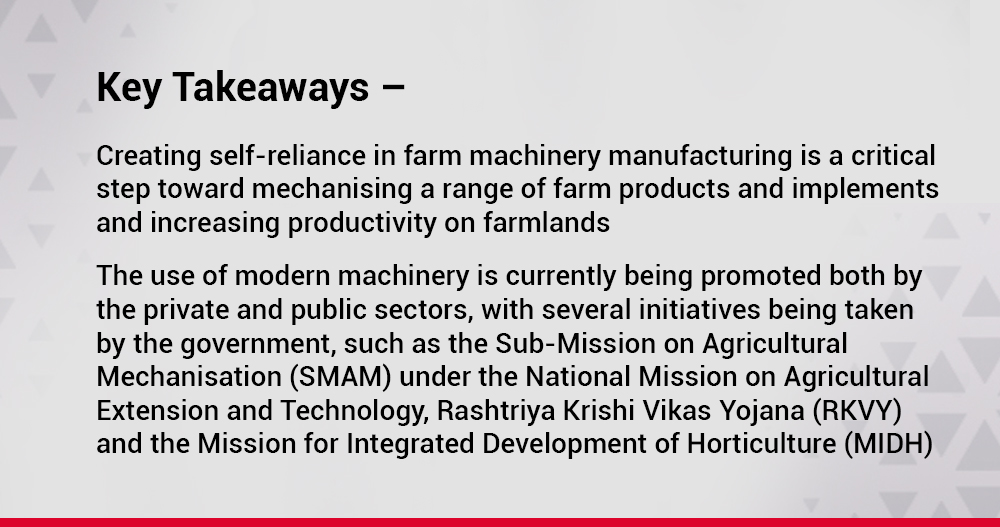
Agriculture continues to be the bedrock of the Indian economy, given that two thirds of India’s population and 70% of its workforce reside in rural areas, generating nearly 46% of the national income, with its contribution to the GDP consistently at over 15% in recent years.
As Covid-19 brought India’s economic growth to a grinding halt, agriculture emerged as the only sector that bucked the trend and aggregated growth. According to the Ministry of Statistics, the agricultural sector’s contribution to GDP has risen from 17.6% in 2018-19 to over 20% in 2020-21.
According to the Agriculture Census 2015-16, small and marginal holdings (less than two hectares) constitute a whopping 86.21% of total land holdings in India, with the average size of Indian land holdings at barely 1.08 hectares.
Having said that, India is one of the largest agricultural economies in the world, and mechanisation on farmlands holds the key to the sustainable and efficient development of this sector. This growth has been on account of several positive factors in the rural economy, leading to the growth of the domestic tractor industry and farm mechanisation overall.
At the global level (India included), growth in the population, food security, and malnutrition are posing serious challenges. Although investments and technological innovations in agriculture over the past few decades have boosted productivity considerably, the pace of increase in farm yields has not been rapid enough to meet emerging challenges and future requirements.
While farm mechanisation in India has made strong strides in recent years, with India being amongst the largest tractor markets in the world, in spite of being highly organised, there is still a long way to go. While there is some level of mechanisation, beyond tractors, it is largely skewed toward land preparation. For many other operations, simple implements are used, or the tasks are done by manual labour. Mechanisation also varies greatly by region, with states in North India having high levels of mechanisation due to highly productive land in the region, as well as declining availability of labour force.
In this direction, the government can support India’s farm mechanisation programme by initiating a series of reforms, including but not limited to promoting indigenous R&D, extending support for crop-specific mechanisation technologies, and boosting India’s competitiveness at the global level.
The farm mechanisation sector, on the other hand, has a far more complex structural composition, with the sector’s performance depending on the interplay of factors that include financial aspects, such as capital and rate of interest, lack of data, small and scattered land holdings etc. Despite all this, farm mechanisation is one of the essential components for the growth of sustainable agriculture in India, especially in the context of diminishing agricultural labour.
But to effectively mechanise India’s farmlands, India needs to innovate while ensuring the growth of the farm mechanisation industry. Here are some pointers to do so:
Restrict imports of farm machinery products to promote “Make in India” and “Atmanirbhar Bharat” initiatives
Import data shows that in eleven months of FY ‘21 (April 2020 to February 2021), the value of farm machinery imported was around INR 1,185 crore, compared to INR 477 crore in FY 2018, i.e., 148% growth in three years. In FY ‘21, 63% of the value of imported farm machinery came from China, making China-based manufacturers significant beneficiaries of the SMAM (Sub-Mission on Agricultural Mechanism) scheme.
Fully imported products dominate two categories of farm machinery, crawler type combine harvesters and rice transplanters, both of which are major beneficiaries of SMAM. In FY ’21, around 70% of crawler-type combine harvesters sold in India were imported, and in the case of rice transplanters, around 60 to 70 % were imported. Global manufacturers were major beneficiaries in both categories.
Grant subsidies /financial assistance for procurement only to farm machinery products with 50% localisation content (by value)
The various government-run (State and Centre) schemes providing financial assistance for the procurement of farm machinery (like SMAM) provide no distinction between a product fully designed and developed in India for Indian farm conditions and a product designed and developed abroad and imported into India. These schemes provide an equal amount of subsidies to all products and thus do not incentivise businesses who have invested in India, to design and develop these products.
Introduction of PLI schemes for farm machinery
India is “Tractorised” and not “Mechanised”. Globally, the tractor industry is only 38% of the total industry (tractor + farm machinery), while in India, the tractor industry is 80% of the total industry (tractor + farm machinery). There is a need to incentivise the farm machinery industry through a PLI scheme to deliver ‘best in class’ products for domestic and export markets.
In conclusion, the Indian tractor industry has been at the forefront of efforts to achieve self-reliance in tractors. We have progressively built an entire ecosystem while launching strategic finance and rental initiatives to make tractors more accessible and affordable to farmers. Going forward with the right approach, farm machinery, a $100 plus billion global industry, has enormous potential and scope to realise Hon’ble Prime Minister Shri Narendra Modi Ji’s vision of ‘Atmanirbhar Bharat’, and with the right kind of farm products made and developed for India, there is no doubt that the agriculture sector will transform in the years to come.
You can also share your thoughts in the Comments section below!




